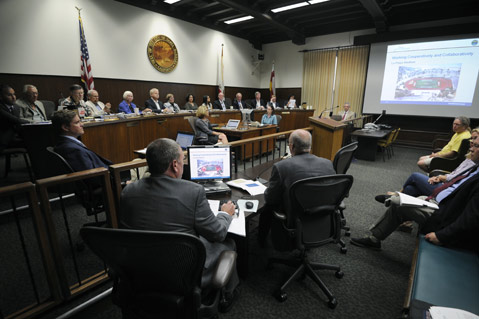SBCC Neighbors Sound Off on Loud, Drunken Students
Complain City Task Force Hasn't Done Enough to Address Problem

Meeting jointly for the second time ever, members of the Santa Barbara City Council and the Santa Barbara Community College Board of Trustees got an angry, if respectful, earful from City College neighbors about loud, drunken, and out-of-control students living next door. They wanted the council to adopt a stricter noise ordinance that would address the growing problems of what was described by one speaker as “Isla Vista East.” And by the meeting’s end, it was clear many councilmembers felt the same way.
One Oceano Avenue resident complained that there’d been 128 calls for police service in an eight-month period about the goings-on of a property owned by one of the city’s better known slumlords. Tires were slashed, he said, and at least one throat, too. A 20-year resident said it was his misfortune to have 6-to-9 City College students living next door. His wife, he said, approached them respectfully to keep it down. “The response is not what you’d expect,” he said, adding he’d called the police at least 20 times for help. Another resident complained of fights, drug deals, and nonstop shouting. “Don’t bother to ask whether I got a good night’s sleep,” she fumed. “I don’t know what I could tell you.”
Inspiring this outpouring of lamentation and woe was a discussion of what progress has been made in the plan adopted last spring by the Neighborhood Improvement Task Force, assembled by City College administrators in response to community complaints. The effort — as well as SBCC President Lori Gaskin — received considerable praise at the time. But mostly, the neighbors didn’t want to hear how a proposed noise ordinance had been caught in a procedural quagmire as downtown hotel, restaurant, and bar owners weighed in on what impact such a measure might have on them.
On the table is a plan modelled on something on the books in San Luis Obispo, where a team of young students trained and employed by city police are dispatched to noisy neighborhoods to issue warning tickets. Failure to comply generates a first-time ticket of $350. After that, the fines increase to $700 and then to $1,000. There, the noise-induced calls for service have dropped by 30 percent. Both landlords and renters can be assessed fines. Because they’re administrative penalties — not criminal — no court trial is required. Councilmembers Frank Hotchkiss, Gregg Hart, and Randy Rowse all pushed city attorney Ariel Calonne to figure out a way to bypass the regulatory conundrum posed by downtown business operators. Stick to residential neighborhoods, he was told.
Councilmembers also pressed City College administrators, like Ben Partee, on what kind of discipline school officials dished out to students who violated the unwritten code of neighborly behavior. Partee took exception to the popular assumption that every troublemaker was, in fact, a City College student. He challenged the school’s critics to give him the transgressors’ names and he’d take care of them. “When we get a name and I can pursue our students I pursue with vengeance,” he said. He pointed out he suspended a City College student who tossed a rock through a neighbor’s window. Partee noted that there are four English language schools catering to students 18 to 24 year sold.
Councilmembers Frank Hotchkiss and Cathy Murillo — rarely on the same side of any issue — pressed Gaskin — about the large number of out-of-town students. Gaskin reiterated that, by law, community colleges can’t deny admission to any state resident; the only limit, she said, is the number of seats. Hotchkiss then asked whether the number of seats could be reduced.
Murillo asked Gaskin point blank whether the college was actively recruiting international or out-of-state students. Gaskin’s answer was, “No.” She noted, however, that the presence of City College and UCSB — two “destination institutions” — was clearly driving enrollments, as was SBCC’s status as a back-door entrance into the increasingly prestigious UCSB. Gaskin said that the college currently puts a cap on out-of-state and international enrollments.
Boardmember Peter Haslund took on the issue of growing enrollments, pointing out how when he arrived in the United States as an immigrant in 1949, the world’s population was roughly half what it is today. “We have a serious global phenomenon,” he said. “Our local areas and our state of California are not immune. We need to find more creative ways to solve the problem.”



